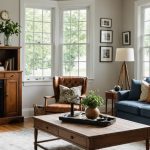Creating a harmonious transition between the exterior and interior of your home can elevate the overall ambiance, offering a cohesive style that resonates with both visitors and residents. You may find yourselves pondering how best to achieve this coordination while considering your unique design preferences and practical needs. This article delves into the nuances of coordinating home decor effectively, ensuring that your house stands out as a singular masterpiece from the front door to the living room.
Understanding Color Harmony
When it comes to achieving a seamless flow between the interior and exterior of your home, understanding color harmony becomes paramount. Colors are not just visual elements; they are emotive tools that can influence the mood and perception of a space. To successfully coordinate the colors of your home, you need a calculated approach.
Also to see : How can I incorporate seasonal decor changes without overwhelming my space?
Choosing a Color Palette
Selecting the right color palette is the cornerstone of your design strategy. Consider starting with a neutral base for both the interior and exterior, which can act as a canvas for more vibrant hues. Neutral colors like whites, beiges, and grays offer flexibility and timeless appeal.
Connecting Exterior and Interior Colors
Look for inspiration from your home‘s natural surroundings. If your house is nestled amidst lush greenery, earthy tones might be the ideal choice. Conversely, if you live in a more urban setting, sleek metallics or bright accents could be more suitable.
Also to see : What are the best ways to display family photos in my home?
Creating a Visual Anchor
Focus on creating a visual anchor that ties the two spaces together. This could be a bold front door color that echoes an accent wall inside the house. Alternatively, consider painting the exterior trim in a shade that harmonizes with indoor furnishings.
By thoughtfully selecting and placing colors, you ensure a fluid transition that feels intentional and well-planned.
Designing with Consistent Style
Establishing a consistent style throughout your home can be a transformative experience. By focusing on coherent design principles, you ensure both the exterior and interior speak the same visual language.
Defining Your Style
Begin by defining your style. Are you drawn to modern minimalism with clean lines and monochrome tones, or do you prefer a vintage charm with eclectic furniture and warm hues? Having clarity about your style preferences sets the stage for harmonious design decisions.
Maintaining Theme Consistency
Consistency is key. If your exterior boasts a rustic charm with natural wood elements, carry this theme inside with wooden furniture and earthy textures. Similarly, a contemporary exterior with sleek finishes should reflect indoors with modern furniture and polished surfaces.
Implementing Lighting
Thoughtful lighting choices can bridge the gap between your inside and outside spaces. Consider installing matching fixtures, such as elegant sconces or pendant lights, that echo the lighting style of your porch or garden in your indoor spaces.
By weaving consistent design elements throughout your home, you craft a space that is both visually appealing and intrinsically connected.
Strategic Use of Furniture and Accessories
While the color and style of your home play significant roles, the strategic use of furniture and accessories can enhance the interior and exterior connection. These elements not only fill space but also add personality and functionality to your home.
Harmonizing Furniture
When selecting furniture, aim for pieces that complement both your indoor and outdoor spaces. For example, a wicker chair set used on the porch can be echoed with similar textures in the living room.
Accessory Coordination
Accessories such as throw pillows, rugs, and art can subtly tie different areas together. Opt for similar patterns or motifs that repeat across both exterior and interior settings. A nautical theme with anchors and stripes could be carried from a beachside patio to a seaside-inspired living room.
Functionality and Flexibility
Incorporate furniture that provides functionality. Outdoor benches with hidden storage or modular sofas that can be rearranged bring practicality. Remember, a well-planned house ensures that every item has a purpose and place.
This strategic approach to using furniture and accessories ensures a best fit for your home, creating a unified look that flows effortlessly between different spaces.
Incorporating Indoor and Outdoor Elements
A beautifully coordinated home doesn’t stop at visual or stylistic elements alone. Incorporating natural elements both inside and outside can create a seamless blend that enhances home aesthetics.
Bringing the Outdoors In
Consider adding houseplants or small indoor gardens to bring a touch of nature indoors. This not only enhances your living space but also improves air quality.
Extending Indoor Comfort Outdoors
On the flip side, bring indoor comforts outside by adding plush cushions, soft throws, or stylish rugs to your patio or deck. Weather-resistant fabrics ensure durability while reflecting your interior textile choices.
Utilizing Natural Materials
Incorporate natural materials such as stone, wood, and metal throughout your spaces. A stone facade or wooden deck can find its counterpart in an exposed brick wall or wooden beam inside the house.
By skillfully blending indoor and outdoor elements, you create a house that feels open and inviting, with soft transitions between nature and structure.
Creating a harmonious home involves an intricate dance between colors, styles, furniture, and natural elements. By carefully considering each aspect and how they relate to both the interior and exterior, you ensure that your home is not only visually appealing but also a reflection of who you are. As you curate a space that resonates with your personality, you transform mere square footage into a cohesive and inviting home. Remember, the key to a beautifully coordinated home lies in finding the delicate balance between continuity and creativity, with each element contributing to a greater whole.











